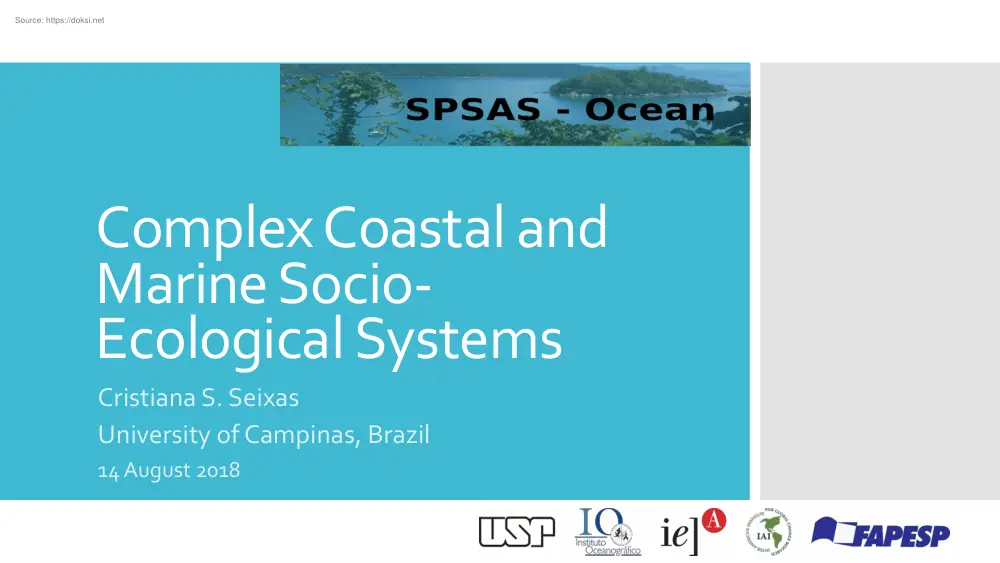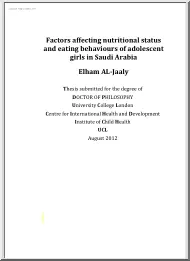Please log in to read this in our online viewer!

Please log in to read this in our online viewer!
No comments yet. You can be the first!
What did others read after this?
Content extract
Complex Coastal and Marine SocioEcological Systems Cristiana S. Seixas University of Campinas, Brazil 14 August 2018 Understand key concepts of complex coastal and marine social-ecological systems 1. Learning objective and outline Complex adaptive systems Social-ecological systems Ecosystem services Scale Resilience Social-ecological systems frameworks Defining your SES Examples of SES SocialEcological systems are Complex System Complex systems exhibit characteristics that stem from the interactions and patterns within the system Non deterministic, unpredictable Process dependent Multiple-scale feedbacks Self-organizaton 3 Complex adaptive system (CAS) When they have the capacity to selforganize, learn and adapt they are complex adaptive systems (CAS) Properties: agregation, non-linearity, diversity, uncertainty, self-organization, resilience 4 blogs.msdncom 5 Complex adaptive behaviour
Informal pedestrian path formation Slow traffic jams Immune systems Stadium waves Human and other animal brains Ants and termites Standing ovations Birds flocking Stock markets Fish schooling Human societies Ecosystems openabm.org Why SocialEcological Systems approach for Oceans research governance? Social ecological system (SES) Human society shapes nature Nature shapes human society Humans and nature coevolving Social and ecological systems are inevitably linked and integrated the delineation between the two systems is artificial and arbitrary (Berkes and Folke 1998) 9 10 Coastal Ecosystem Services Scales and Levels (Cash et al. 2006) Holling et al. (1995) observed that: Ecological change are not gradual and continuous, they are epsotic Ecosystem dynamics Spatial attributes are not uniform or unvariable at different scales Ecosystem has no singular equilibrium state, but
may have alternating stable states and multiple equilibria Ecosystem are hierarchically structured (panarchy) Holling’s Adaptive Renewal Cycle (1986) Scale: processes and variables on different size and temporal cycles Scale and cycle mis-matches can challenge governance • Geological, climate etc. cycles • Project versus political cycles • Policy and management cycles • Legal and institutional cycles Gunderson, Lance and C. S Holding Resilience (Holling 2001) the extent to which ecosystems can absorb recurrent natural and human perturbations and continue to regenerate without slowly degrading or unexpectedly flipping into alternate states the capacity of a system to absorb disturbance, undergo change and still retain essentially the same function, structure, identity, and feedbacks 16 Resilience (Gunderson 2000) Valleys represent stability domains, balls represent the system, and arrows represent disturbances. Engineering resilience is
determined by the slopes Ecological resilience is described as the width. Adaptive capacity refers to the ability of the system to remain in a stability domain, as its shape changes (http://mysite.verizonnet/vzesz4a6/current/id610html) Losing resilience Shifting domains Transformability Resilience "Resilience" as applied to ecosystems, or to integrated systems of people and the natural environment, has three defining characteristics: 1. The amount of change the system can undergo and still retain the same controls on function and structure 2. The degree to which the system is capable of self-organization 3. The ability to build and increase the capacity for learning and adaptation http://www.resallianceorg Examples of Frameworks Linking Social and Ecological System Analysis oriented Action oriented The Resource system approach for fisheries mng’t (Charles 2001) SocialEcological Systems in traditional management systems (Berkes et al. 2003)
Analyzing Sustainability of SocialEcological Systems – (Commons) Ostrom’s Framework (2009) Another version of Ostrom’s framework SocialEcological Systems for Community Conservation (Berkes et al 2015) ) DPSIR (European Environmental Agency) Millennium Ecosystem Assessment Framework (MA 2005) IPBES Conceptual Framework (Diaz et al. 2015) Defining your SES What is your question? What is the problem you wish to address? Who are the stakeholders? Their interests? Their values? Their knowledge? In what biophisical (ecosystem) scale the problem can be addressed? In what social (institutional scale) scale the problem can be addressed? What time scale is needed to answer your question? Multiple stakeholders Urban Sewage disposal Mariculture Oil & Gas Different fisher groups Harbor Researchers Nuclear power plant Protected areas Fish traders Navy Beach tourism Sight seeing tourism diving Example from The Caribbean
Spatial (geographical area) Jurisdictional (administration) Network (links and ties) Gulf & Carib. International Regional Sub-region Regional Industry Country National Organization Watershed District Household Settlement Community Individual “social” The Caribbean social-ecological system 33 “ecological” Nested institutions of governance Cultural and societal values Sustainable development framework EBM fisheries or MPA plan Community managed area local level plan Multi-scale policy-cycles are based on regional governance framework Key indirect drivers leadings to direct drivers of ecosystem change in the Brazilian coast zone (Marone et al. 2011) DPSIR analysis of marine pollution Ibiraquera Lagoon, South Brazil Parnarchy and Adaptive cycles Focus on fisheries mgn’t (Seixas & Berkes 2003) Aventureiro, Ilha Grande Rio de Janeiro Brazil Foto: INEA Foto: INEA Foto: INEA Por D. Prado C. S Seixas Pathway of
socialecological change - focus on livelihoods (Prado et al. 2015) Selforganization of SES in integrated conservation and development initiatives (Seixas & Davy 2008) Pred Nai community, Thailand Mangrove forest restoration and management (Senyk 2005) Q: Shall one foster resilience in SES? Building resilience in local socialecological lagoon systems (Berkes & Seixas 2005) 7 Principles for Building Resilience in Social-Ecolgical Systems (Simonsen et al. 2015) Maintain diversity and redundancy Manage connectivity Manage slow variables and feedbacks Foster complex adaptive systems thinking Encourage learning Broaden participation Promote polycentric governance systems Thank you!
Informal pedestrian path formation Slow traffic jams Immune systems Stadium waves Human and other animal brains Ants and termites Standing ovations Birds flocking Stock markets Fish schooling Human societies Ecosystems openabm.org Why SocialEcological Systems approach for Oceans research governance? Social ecological system (SES) Human society shapes nature Nature shapes human society Humans and nature coevolving Social and ecological systems are inevitably linked and integrated the delineation between the two systems is artificial and arbitrary (Berkes and Folke 1998) 9 10 Coastal Ecosystem Services Scales and Levels (Cash et al. 2006) Holling et al. (1995) observed that: Ecological change are not gradual and continuous, they are epsotic Ecosystem dynamics Spatial attributes are not uniform or unvariable at different scales Ecosystem has no singular equilibrium state, but
may have alternating stable states and multiple equilibria Ecosystem are hierarchically structured (panarchy) Holling’s Adaptive Renewal Cycle (1986) Scale: processes and variables on different size and temporal cycles Scale and cycle mis-matches can challenge governance • Geological, climate etc. cycles • Project versus political cycles • Policy and management cycles • Legal and institutional cycles Gunderson, Lance and C. S Holding Resilience (Holling 2001) the extent to which ecosystems can absorb recurrent natural and human perturbations and continue to regenerate without slowly degrading or unexpectedly flipping into alternate states the capacity of a system to absorb disturbance, undergo change and still retain essentially the same function, structure, identity, and feedbacks 16 Resilience (Gunderson 2000) Valleys represent stability domains, balls represent the system, and arrows represent disturbances. Engineering resilience is
determined by the slopes Ecological resilience is described as the width. Adaptive capacity refers to the ability of the system to remain in a stability domain, as its shape changes (http://mysite.verizonnet/vzesz4a6/current/id610html) Losing resilience Shifting domains Transformability Resilience "Resilience" as applied to ecosystems, or to integrated systems of people and the natural environment, has three defining characteristics: 1. The amount of change the system can undergo and still retain the same controls on function and structure 2. The degree to which the system is capable of self-organization 3. The ability to build and increase the capacity for learning and adaptation http://www.resallianceorg Examples of Frameworks Linking Social and Ecological System Analysis oriented Action oriented The Resource system approach for fisheries mng’t (Charles 2001) SocialEcological Systems in traditional management systems (Berkes et al. 2003)
Analyzing Sustainability of SocialEcological Systems – (Commons) Ostrom’s Framework (2009) Another version of Ostrom’s framework SocialEcological Systems for Community Conservation (Berkes et al 2015) ) DPSIR (European Environmental Agency) Millennium Ecosystem Assessment Framework (MA 2005) IPBES Conceptual Framework (Diaz et al. 2015) Defining your SES What is your question? What is the problem you wish to address? Who are the stakeholders? Their interests? Their values? Their knowledge? In what biophisical (ecosystem) scale the problem can be addressed? In what social (institutional scale) scale the problem can be addressed? What time scale is needed to answer your question? Multiple stakeholders Urban Sewage disposal Mariculture Oil & Gas Different fisher groups Harbor Researchers Nuclear power plant Protected areas Fish traders Navy Beach tourism Sight seeing tourism diving Example from The Caribbean
Spatial (geographical area) Jurisdictional (administration) Network (links and ties) Gulf & Carib. International Regional Sub-region Regional Industry Country National Organization Watershed District Household Settlement Community Individual “social” The Caribbean social-ecological system 33 “ecological” Nested institutions of governance Cultural and societal values Sustainable development framework EBM fisheries or MPA plan Community managed area local level plan Multi-scale policy-cycles are based on regional governance framework Key indirect drivers leadings to direct drivers of ecosystem change in the Brazilian coast zone (Marone et al. 2011) DPSIR analysis of marine pollution Ibiraquera Lagoon, South Brazil Parnarchy and Adaptive cycles Focus on fisheries mgn’t (Seixas & Berkes 2003) Aventureiro, Ilha Grande Rio de Janeiro Brazil Foto: INEA Foto: INEA Foto: INEA Por D. Prado C. S Seixas Pathway of
socialecological change - focus on livelihoods (Prado et al. 2015) Selforganization of SES in integrated conservation and development initiatives (Seixas & Davy 2008) Pred Nai community, Thailand Mangrove forest restoration and management (Senyk 2005) Q: Shall one foster resilience in SES? Building resilience in local socialecological lagoon systems (Berkes & Seixas 2005) 7 Principles for Building Resilience in Social-Ecolgical Systems (Simonsen et al. 2015) Maintain diversity and redundancy Manage connectivity Manage slow variables and feedbacks Foster complex adaptive systems thinking Encourage learning Broaden participation Promote polycentric governance systems Thank you!




